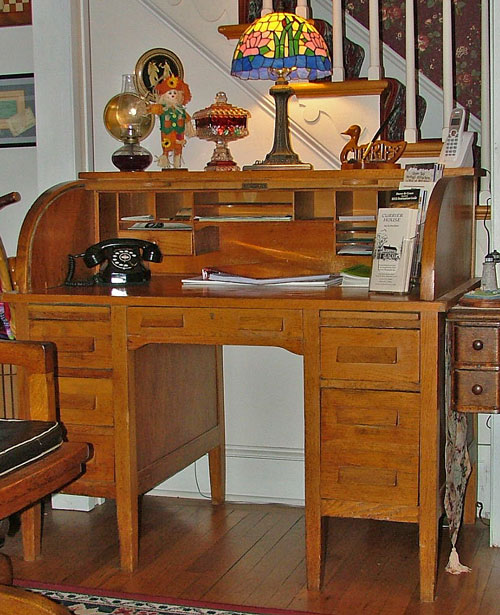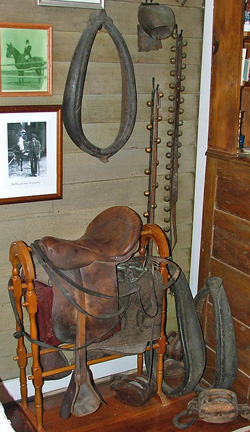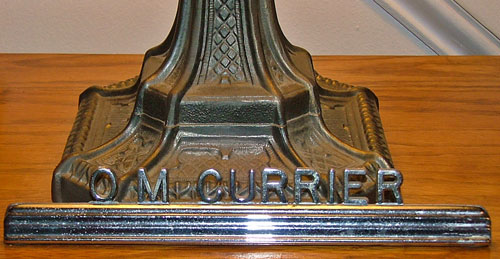excerpted from an article in “Lockhouse to Lighthouse” in Spring 1999 by Ellie Mencer
This article shifts slightly from the water-oriented stories of past issues and focuses on the livery stable. Jane Currier of the Currier House B&B graciously shared a handful of the thousands of pieces of papers, receipts and photographs that were found in the house during renovations.
 Jane’s Aunt “Honey” lives* in Susquehanna Hills and remembers well life at the livery stable. She recalls being told that around 1892 the livery stable was located on Pearl Street. She thinks it was about that time it was moved to Franklin & Union for a short while. Then it was moved to Franklin & Stokes Street where the building still stands. (It recently housed Mergler Electric.)
Jane’s Aunt “Honey” lives* in Susquehanna Hills and remembers well life at the livery stable. She recalls being told that around 1892 the livery stable was located on Pearl Street. She thinks it was about that time it was moved to Franklin & Union for a short while. Then it was moved to Franklin & Stokes Street where the building still stands. (It recently housed Mergler Electric.)
 Jane’s grandfather, O.R. Currier, operated the Havre de Grace Livery Stable until his death in 1939. The livery stabled 36 horses on a permanent basis. Fifteen horses were kept on the second floor with the office and tack room. The balance were kept on the first floor along with the large wagon that was used with the three Clydesdale horses.
Jane’s grandfather, O.R. Currier, operated the Havre de Grace Livery Stable until his death in 1939. The livery stabled 36 horses on a permanent basis. Fifteen horses were kept on the second floor with the office and tack room. The balance were kept on the first floor along with the large wagon that was used with the three Clydesdale horses.
Aunt “Honey” remembers that there were two funeral hearses: a gray for younger people pulled by gray horses and a black one for older people pulled by black horses. They also had sleighs and buggies.
Honey also recalls that the hay was kept on the third floor. Now picture this: a pulley system was used to get the hay to the third floor. A horse was tied to the pulley system and had to walk all the way to the Presbyterian Church (more than half a block away) to be able to pull the hay high enough to get it in through the third floor window! Next time you’re out for a walk, go check it out for yourself.
 The livery stable papers can really tell a great deal about the city’s history. Moving loads of raw materials and finished goods to the canals, the wharf and the trains kept O.R. Currier well aware of what was happening in town. Receipts for lumber being delivered would tell when and whose house or building was being constructed.
The livery stable papers can really tell a great deal about the city’s history. Moving loads of raw materials and finished goods to the canals, the wharf and the trains kept O.R. Currier well aware of what was happening in town. Receipts for lumber being delivered would tell when and whose house or building was being constructed.
The large wagon and Clydesdale horses would move heavy loads of building materials and pick up shipments from the Pennsylvania Railroad and also the wharf at the foot of Otsego Street. Tons of sand were being purchased here for delivery to the railroad and ships at the wharf. Another unique fact was that there are many receipts from Texaco, presumably kerosene oil for lamps, etc. since these were dated before automobiles.
Honey remembers that the Vandiver horses were kept at the livery. She also recalls that a large wagon was used to haul Havre de Grace people to Bel Air for jury duty, sporting events or any type of business. It was the only transportation before cars. Wow, that makes for a lengthy trip to go to the mall!
O.R. Currier rented out sleighs for races on Union Avenue and the water’s edge when the ice was frozen. Called the Union Avenue Sleigh Races, they were evidently well organized. He also rented buggies and horses to salesmen who came to town on the PA Railroad.
 In 1918 the horses, wagons and trappings were all sold to Guilding Nitrate Company. The livery was changed to a gas station and storage company to be prepared for changing times. In the Currier B&B a picture hangs of the first gas pump at the station.
In 1918 the horses, wagons and trappings were all sold to Guilding Nitrate Company. The livery was changed to a gas station and storage company to be prepared for changing times. In the Currier B&B a picture hangs of the first gas pump at the station.
O.R. Currier was also the first chief of the Susquehanna Hose Company. Most likely the horses at the livery made him very important to the fire company. He held that position for fifteen years.
There’s a great deal more to learn from the small pieces of information that Jane Currier shared with me. Consider these receipts:
- $1.00 for 9 KWH of electricity used the month of May 1915
- $17.15 for City Taxes in 1900 (tax on $2900.00)
- 10 new horse shoes for a total of $10.00
- 14925 gals. water consumed from June 27 to Sept 25, 1915 @ 30 cents per thousand gallons = $4.47
- A total of $23.20 for carriage repairs and painting from June 24 to Nov. 17, 1915
 We hope this gave you a small glimpse of life in Havre de Grace in the early 1900s.
We hope this gave you a small glimpse of life in Havre de Grace in the early 1900s.
*Jane’s Aunt “Honey” has since passed away. I’m so pleasedl that we were able to get this story.

